Trending
Opinion: How will Project 2025 impact game developers?
The Heritage Foundation's manifesto for the possible next administration could do great harm to many, including large portions of the game development community.

Featured Blog | This community-written post highlights the best of what the game industry has to offer. Read more like it on the Game Developer Blogs or learn how to Submit Your Own Blog Post
Navigating a series of professional peaks and valleys, Erich Schaefer and Travis Baldree consider leaving Runic Games to form a new development studio. Their team: just the two of them.

Author's note: And Then There Were Two is a serialized account of the making of Rebel Galaxy by Double Damage Games. The story originated on Episodic Content, my blog devoted to nonfiction stories of videogame design, development, and culture.
Written by David L. Craddock
From the Rubble A dirt path cuts through the heart of Tristram’s town square and leads into the mouth of the cathedral, lolling out of the entryway like a profane tongue. The path is well-trodden, frequented by millions of gamers offline and on Blizzard’s free Battle.net server. Back and forth they walk, receiving convalescence from the healer, implements of steel from the blacksmith, and information as old and mystical as the town elder who disseminates it. Then they follow the path back to the cathedral, stepping into the blood-red light that pours from its maw, letting it swallow them whole.
A dirt path cuts through the heart of Tristram’s town square and leads into the mouth of the cathedral, lolling out of the entryway like a profane tongue. The path is well-trodden, frequented by millions of gamers offline and on Blizzard’s free Battle.net server. Back and forth they walk, receiving convalescence from the healer, implements of steel from the blacksmith, and information as old and mystical as the town elder who disseminates it. Then they follow the path back to the cathedral, stepping into the blood-red light that pours from its maw, letting it swallow them whole.
Erich Schaefer knows that path better than anyone. He should. He paved it.
In 1993, Erich and his brother Max cofounded Condor, Inc., with David Brevik, a mutual friend they met while working at a clipart company called FM Waves. They ran Condor on a shoestring budget, hiring programmers and artists to plug away at meager contracts for console games such Justice League Task Force on Sega Genesis and a few football games for Nintendo’s Game Boy.
Console games paid peanuts, but kept the lights on. Condor’s big break came in the spring of 1995 when they pitched Diablo, a hack-and-slash RPG, to Allen Adham, cofounder of Blizzard Entertainment. The premise was simple, but addictive. Players chose one of three archetypical characters and then headed below the surface on a journey to Hell, harvesting randomized loot that burst from monster corpses. Diablo consisted of 16 levels, each pieced together according to a series of algorithms that guaranteed a fresh experience every game. Erich was the sole architect of those levels; he painted individual tiles in dirt, stone, and fire, then worked with programmers to help develop the algorithms that arranged them in pseudo-random configurations.
By the end of 1996, Condor had been renamed Blizzard North, and Diablo had released to widespread acclaim and blockbuster sales numbers. Blizzard North followed up in 2000 with Diablo II, an even more ambitious game so popular that its multiplayer servers buckled under the weight of demand on its first day of sale.
Erich found his niche on Diablo II. Turning over the task of painting environments to more capable artists, he immersed himself in spreadsheets. Like a mad scientist at the control panel of his latest creation, Erich tweaked numbers—damage values, equations used to determine reward probabilities, other formulas. Then he would boot the game, see how his numbers panned out, and pull the spreadsheets back up to tighten more screws.
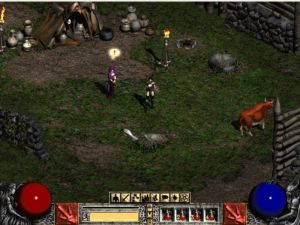 Three years later, Erich found himself in a slump. Blizzard North had ballooned from an intimate team of 15 people during work on Diablo, to more than 60 after the release of Diablo II. The company had split into multiple teams working on projects that started hot only to fizzle out a few weeks or months later. At the end of July 2003, Dave, Max, and Erich got into a dispute over business terms with then-parent company Vivendi and were unceremoniously dismissed. The trio assembled their team in Blizzard North’s main conference room and broke the news that they would be leaving the company they had built, effective immediately.
Three years later, Erich found himself in a slump. Blizzard North had ballooned from an intimate team of 15 people during work on Diablo, to more than 60 after the release of Diablo II. The company had split into multiple teams working on projects that started hot only to fizzle out a few weeks or months later. At the end of July 2003, Dave, Max, and Erich got into a dispute over business terms with then-parent company Vivendi and were unceremoniously dismissed. The trio assembled their team in Blizzard North’s main conference room and broke the news that they would be leaving the company they had built, effective immediately.
Deep down, Erich was relieved. Blizzard North had grown too big for his comfort. He wanted to get back to leaner, meaner days when he and a few close friends had worked together to create simple and addictive games. Two months later, Erich cofounded Flagship Studios in San Francisco with Dave, Max, and several friends from Blizzard North. Their first and only game was Hellgate: London, a futuristic, Diablo-style game set in dystopian London.
Four years and millions of dollars in development costs later, Hellgate limped across the finish line. Reviews ranged from middling to poor. While many critics enjoyed the bleak and gritty visual style, as well as the hack-and-shoot gameplay and addictive loot system, others catalogued a litany of problems. The environments, procedurally generated like Diablo’s, were drab and repetitive—consisting primarily of abandoned subway stations and streets cluttered with debris. The game crashed frequently, and the third-person medieval combat and first-person shooting seemed at odds: Hellgate, these critics declared, suffered from an identity crisis. It didn’t know what it was supposed to be. Neither did its creators.
“Essentially we grew too big, too fast,” Erich said. “We were too ambitious and tried to be everything to everybody, and ended up falling short of anything to anybody. The game sort of grew too big, and our goals grew too big, and the whole company exploded.”
 Rumors of Hellgate’s awfulness have been greatly exaggerated.[1] It holds an aggregate score of 71% on Metacritic, sold roughly 1 million copies and, according to Erich, hit a peak of roughly 80,000 concurrent users on Ping0, Flagship’s proprietary online service. The cofounders pleaded their case to their publishing partners.
Rumors of Hellgate’s awfulness have been greatly exaggerated.[1] It holds an aggregate score of 71% on Metacritic, sold roughly 1 million copies and, according to Erich, hit a peak of roughly 80,000 concurrent users on Ping0, Flagship’s proprietary online service. The cofounders pleaded their case to their publishing partners.
“We said, ‘Hey, guys, we need money to continue and get this game into shape, and keep making ongoing content like we promised everybody,'” Erich explained, referring to Flagship’s promise of a monthly fee or lifetime subscription for Hellgate: London that guaranteed players exclusive content. “Nobody really wanted to foot the bill on that. They all had too small a piece of the pie, and we kind of exploded because these business relationships which we thought were brilliant, kind of weren’t.”
By the summer of 2008, Flagship was hemorrhaging money. Flagship’s cofounders made a list-ditch effort to salvage the company by approaching a partner who agreed to cut a check, only to back out at the last minute. “They were probably wise to do so, honestly. I won’t name the company,” Erich said.
In mid-July, Erich relived the nightmare of his final hours at Blizzard North. Together with his cofounders, he called Flagship’s 125 developers into conference room and broke the bad news. “That was kind of… I still think of that as the worst day in my career, and one of the worst days of my life, really—when we had to call in everybody and say, ‘You know what, everybody? We keep trying to put [on] a positive face, but this thing’s done.’ We had to send everybody home.”
Tangents
 Diablo and Diablo II inspired tens of millions of players to spend hundreds of hours at their computers clicking monsters and salivating after more treasures. Travis Baldree was among them, but he wanted to do more than play Diablo games. He wanted to write them. “I’d been at WildTangent for five or six years; I was one of the earliest employees, and at that point I had a lot of leeway in what I could do and what they let me get away with.”
Diablo and Diablo II inspired tens of millions of players to spend hundreds of hours at their computers clicking monsters and salivating after more treasures. Travis Baldree was among them, but he wanted to do more than play Diablo games. He wanted to write them. “I’d been at WildTangent for five or six years; I was one of the earliest employees, and at that point I had a lot of leeway in what I could do and what they let me get away with.”
Headquartered in Seattle, WildTangent is a casual-oriented company that turns out clones of popular mainstream games. The Blasterball series unabashedly mimicked the brick-breaking antics of Breakout, and Final Drive mirrored high-octane racers like Burnout and Need for Speed. In 2004, Travis pitched a clone of Diablo instead of racers and brick breakers, but with a twist. His game, Fate, would sport a 3D pedigree, and feature Diablo’s isometric camera.
“They hemmed and hawed a little bit because they couldn’t figure out how that would map to their casual audience they were supposedly targeting. But at that point I could kind of do whatever I wanted, so I did it.”
WildTangent’s principals gave Travis two months to develop Fate. He took six, devoting the bulk of the time to writing a custom graphics engine, and add innovative new features like a pet that could haul unwanted items up to town and sell them, keeping players focused on hacking and slashing. “Until [Rebel Galaxy], it was probably the most enjoyable project I ever did.”
Fate sold like gangbusters, causing Travis’s bosses to do a 180 and task him with developing a sequel. The idea didn’t sit well with him. He wanted to do something new, not toil away on iterations—the WildTangent du jour. After hours, he tinkered around on side projects with Phil Shenk, an artist and animator renowned for his work as the lead character artist on Diablo II and lead designer on Diablo II’s expansion set, Lord of Destruction.
Phil had left Blizzard North in the summer of 2003 to cofound Flagship Studios with Max and Erich Schaefer. Once Flagship got up in running, Phil—who had worked at WildTangent in between his time at Blizzard and Flagship—phoned Travis to make him an offer. So did Blizzard North. “I ended up turning them both down because we’d just had a kid. She was just a couple of months old, and moving to a more expensive state at a reduced salary, and my wife going where she didn’t know anybody, with an infant, just didn’t sound great.”
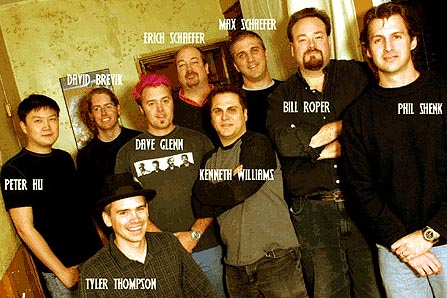
Image: DiabloII.net
A month or two later, Phil called Travis again with a better offer. “They had this idea that they could make a smaller project that they could use as the proverbial canary in the mineshaft to test out network stuff,” Travis explained. “They could have me do that, and then I could use the Hellgate codebase and build a separate, Diablo-style game on top of it that they would put out for free to prove out the network infrastructure in advance of the release of Hellgate.”
This time, Travis said yes. He worked from his home in Seattle, where he laid the groundwork for a Diablo-style game codenamed Project Tugboat. Eventually, Flagship’s bosses sprung for an office in Seattle. Travis moved in and was joined by a few others. Project Tugboat evolved far past its humble beginning as a mere network test into a high fantasy game called Mythos, and gained traction with players involved in its closed beta tests.
Max Schaefer grew into one of Mythos’s biggest supporters. He flew up to Seattle regularly to discuss the game’s progress with Travis and the team. As Mythos matured, Max and Travis set off on a press tour across Europe to promote it. The trip was a whirlwind; they visited seven cities in under four days. “We went to Cologne and I never saw it during the daytime,” Travis said. “We got there at, like, 9:00 p.m., and then went to some midnight broadcast, and then flew out before it was even light the next morning.”
(Torch)light at the End of the Tunnel
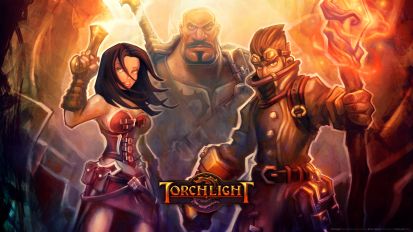 Max and Travis hit it off right away, building a friendship and mutual trust that the demise of Flagship could not unravel. As Erich told it, “Max and Travis were hatching this idea of starting a new company based on the remnants of Flagship Seattle. The initial idea was they were going to continue with Mythos, if possible, which was very unlikely because the rights to Mythos were owned by the Korean company, Hanbitsoft, that was working with us on Hellgate: London. But we just wanted to keep the team together and make a game like Mythos, was the idea.”
Max and Travis hit it off right away, building a friendship and mutual trust that the demise of Flagship could not unravel. As Erich told it, “Max and Travis were hatching this idea of starting a new company based on the remnants of Flagship Seattle. The initial idea was they were going to continue with Mythos, if possible, which was very unlikely because the rights to Mythos were owned by the Korean company, Hanbitsoft, that was working with us on Hellgate: London. But we just wanted to keep the team together and make a game like Mythos, was the idea.”
Erich was on board, though he wanted to stick to the background this time around. “I was kind of thinking, Well, if this thing crashes, I’m just going to take a year off. I’m just going to figure out what’s going on and take a break. It was a very stressful time. But it turns out that didn’t happen at all.”
When Flagship began to sink, the Schaefers directed everyone toward their lifeboat. Most of the guys opted to swim. Dave Brevik went to Gazillion and managed the development of Marvel Heroes, the online MMO baked in Diablo’s mold. Bill Roper landed at Cryptic Studios, makers of superhero-themed online games, and later took a top position at Disney Interactive, helping to shepherd games bearing the Marvel license.
One of the guys who set sail for new horizons with the Schaefers and Travis Baldree was Peter Hu, a programmer who had worked with Max and Erich since the Diablo II days. Max, Erich, Travis, and Peter pooled their money in 2008 and formed Runic Games, a studio cobbled together from the castaways of Flagship Seattle. A few lucky breaks got them off to a running start. “One of the early, cool deals that came about was that one of our creditors from Flagship—I think it was Bank of America—was selling off all our computer equipment,” Erich said. “So Runic Games bought all the computer equipment from Flagship, through Bank of America, for something really cheap. It was kinda neat and helped us get this new company off the ground.”
Erich voluntarily remained in the background, happy to kick in seed money and monitor progress from afar. Travis took charge of Runic, as he had taken charge of Flagship Seattle. His cofounders didn’t mind. He reminded Erich and Max of Dave Brevik: a programmer so sharp and fast that he was almost a coding magician, able to pull prototypes out of a hat. His proposal was simple. Runic was a small team walking a financial tightrope. Therefore, they would need to keep their vision small and focused. Mythos was off limits; projects in the style of Diablo, their bread and butter, were not.
As a matter of fact, Travis’s proposition for Runic’s first game hewed close to the original Diablo—an action-RPG featuring three hero classes and set in a town that lay overtop a stack of dungeon levels. One aspect of the pitch flew in the face of Blizzard North’s breakout hit. “We didn’t want to go straight to multiplayer because I was terrified of it—all the network tech. I wanted to do a single-player [game] first, so we pitched with that in mind,” Travis said.
Travis’s other cofounders saw the necessity of stripping multiplayer from Runic’s first game. “We wanted to give this team—which had been working on Mythos for so long and had it crash out from under them—we wanted to give the team confidence that we could make a game, get it out there, and that everything was going to be okay,” Erich said.
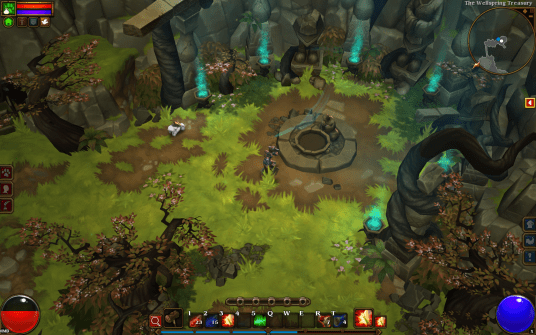 Erich’s confidence and enthusiasm for Torchlight grew alongside his team’s. “As Runic Games started to take form over time, and as we started to figure out deals, I got more involved in this thing. I started to represent myself as, ‘Yeah, of course I’m going to be working on this’ to investors. As soon as we started to make the game, I had already fallen in love with Torchlight. I was doing all my normal design stuff on it anyway.”
Erich’s confidence and enthusiasm for Torchlight grew alongside his team’s. “As Runic Games started to take form over time, and as we started to figure out deals, I got more involved in this thing. I started to represent myself as, ‘Yeah, of course I’m going to be working on this’ to investors. As soon as we started to make the game, I had already fallen in love with Torchlight. I was doing all my normal design stuff on it anyway.”
China-based publisher Perfect World signed on to help distribute Torchlight, and the small team at Runic—directed by Travis—plugged away on the game. Quite naturally, Travis and Erich developed a tighter bond. “Max and I spent a lot of time working together and talking about stuff during the Flagship North days. That all more or less changed at Runic because Erich was directly working on [the Torchlight games], doing skill design and stuff like that, so I interfaced with Erich more on a daily basis during that period,” Travis said.
By the end of 2009, Runic’s cofounders had accomplished their goal. Torchlight released on digital download vendors such as Steam and sold for the budget price of $19.99. Over 500,000 gamers purchased the game for PC in just six months, topping off Runic’s coffers, and garnering critical acclaim for its addictive gameplay, charming graphics, and atmospheric soundtrack composed by famed Diablo composer Matt Uelmen.
They had only one complaint. “After we released it, the prevailing comment was, ‘Well, why isn’t this multiplayer? It’s not Diablo if it’s not multiplayer,'” Travis recalled. Runic announced plans to put the complaints regarding Torchlight’s lack of online connectivity to rest, and then some—their next project would be an MMO set in the Torchlight world, with the same frenetic, mouse-click-driven gameplay. Before work got deep underway, Travis called a mulligan.
“I was terrified of that, still,” he said, referring to the daunting prospect of building an infrastructure complex and massive enough to support always-on play. “Diablo went from this one-town-one-dungeon [design] and then expanded, becoming a larger multiplayer game while still not becoming an MMO. It was my proposal that we follow the same route, because that’s what everybody wanted from Torchlight anyway.”
Travis ran the idea by the Schaefers and Peter Hu. What should have been a quick turnaround stretched out interminably. “We said, ‘Let’s do that instead. We can do that in 18 months! Ha ha ha! We’ll get that out the door, and it’ll just be kind of another step on the road.'”
By the time Runic launched Torchlight II in September 2012, the projected 18-month cycle had nearly doubled thanks to a major speed bump. Halfway through development, theteam splintered, with half working to port the original Torchlight to the Xbox 360. “That did not really go that well; there was a lot of panic and shuffling around to get that thing out the door, going from crunch to crunch,” Travis said. “Eventually we did ship Torchlight II, after Diablo III, but it did fine and we were still all alive.”
Zelda Galaxies

Schaefer (left) and Baldree.
Runic sold over 1 million copies of Torchlight II by the end of 2012. Factoring in sales from the Xbox 360 port of Torchlight, the company was sitting pretty. They were also exhausted.
“We made a ton of money off those, did really well, and started to say, ‘Hey, what are we going to do next?’ And like in the old Blizzard North days, nobody wanted to do Torchlight III immediately. Everybody wanted to do something new,” Erich said.
Following a company-wide breather, Travis convened a meeting of the cofounders and suggested they discuss what to make next. Concepts piled up, and were narrowed down to two. One was a randomized adventure-type game in the vein of Nintendo’s Legend of Zelda series. It would be a 3D game heavy on exploration, through randomized environments.
The second finalist came from Erich. “I forget what the title was. I think I called it Galaxy Blasters. [laughs] That was a working title. It was a space game that had roots in the game we’d been working on at Blizzard [North] right before we left, which was code-named Starblo. It was like Diablo in space.”
Starblo had been in an embryonic state prior to Erich’s, Max’s, and Dave’s dismissal from Blizzard North. The idea was that players would get their own spaceship that functioned like a town. They could fly around the galaxy, landing on planets and extraterrestrials in typical Diablo fashion, and then return to the ship to buy and sell goods.
Travis liked the gist of Erich’s space-themed action game and called for a vote. Galaxy Blasters—which became known internally as “spacegame”—won. Adjourning, the cofounders announced to the team what they’d be making next. Everyone looked Travis, waiting. Travis was president of Runic Games. Around the office, he was their fearless leader; it was customary to wait for him to fire the starting pistol.
Over a weekend at home, he lifted assets from Homeworld 2 (a customary practice in the games industry used by developers to assemble quickie proofs of concept) and hacked together a prototype that incorporated a notion inspired by his recently gaming habits. “I thought it’d be cool if we did broadside combat to make it different, because I played Assassin’s Creed IV: Black Flag and I’m very impressionable,” he explained with a chuckle.
 An exclusive screenshot from an early prototype of the game that became Rebel Galaxy. Image: Travis Baldree.
An exclusive screenshot from an early prototype of the game that became Rebel Galaxy. Image: Travis Baldree.
Back at the office on Monday, he booted up his prototype. Great, lumbering capital ships floated through a starry void. When players wanted to disembark, they could drift over to a planet and unload a squad to explore and complete missions on the surface—a gameplay structure analogous to the original X-COM: UFO Defense published in 1994, and the remake, XCOM: Enemy Unknown from 2012.
“Initially it was going to be a game where you were Nikola Tesla, and you had left earth because Thomas Edison was an ass, and gone into suspended animation in this very chunky, Tesla-y spaceship,” Travis said. “Then you wake up a lot later out in the depths of space.”
Erich was ecstatic. Working on a sci-fi action game was a breath of fresh air after nearly 20 years of building dank, moldy dungeons for Diablo and its ilk. Over the next five months, his enthusiasm waned. “The scope kind of got bigger than what I pitched. It got a little out of control, and development slowed down, and people kind of lost interest.”
History was repeating itself before Erich’s eyes. Runic had staffed up to handle Torchlight II and the conversion of Torchlight to Xbox 360. As a result, the team had become as bloated and unwieldly as the capital ships they were designing.
Travis’s frustration mirrored Erich’s. He wanted to continue working on the game, but the majority of Runic expressed disinterest. “We just killed it all. We never got very far,” Travis said.
The cofounders went back to the drawing board and picked the randomized Zelda game, which would later be renamed Hob. Erich’s malcontent worsened. Runic’s fleet of programmers and designers were honing in on his turf. “I didn’t have too much of a role on it. I didn’t have a ton to do; there wasn’t a bunch of data for me to work with; there weren’t a bunch of characters, monsters, and loot—all the things I usually [work with].”
One morning in early 2014, Erich’s phone rang. “Until a big day happened, and that’s when Travis gave me a call. This is maybe a chapter break, almost. [laughs]”
And Then There Were Two
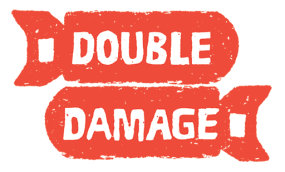 Travis sounded as downtrodden as Erich had ever heard him. He explained he was tired of attending meetings, tired of having to get consensus, tired of pushing papers. Within the next few months, he would be leaving Runic Games to reclaim control over his creative destiny.
Travis sounded as downtrodden as Erich had ever heard him. He explained he was tired of attending meetings, tired of having to get consensus, tired of pushing papers. Within the next few months, he would be leaving Runic Games to reclaim control over his creative destiny.
“I like to make stuff,” Travis stated simply. “I like to be knee-deep in things. I like making art, I like making levels, I like doing everything. But as your company grows beyond a couple of people, that’s really not acceptable. Everybody has their fiefdom; they have their area, and you don’t mess around in other people’s ponds. It really wasn’t appropriate for me to do the things I wanted to do, and I was ready to move on and make games the way I like making games.”
Travis’s jack-of-all-trades role at Runic reminded Erich of the leadership position Dave Brevik had held at Blizzard North. He was the keystone, the conduit through which creativity flowed. “I really viewed Runic Games as Travis, and 30 people trying to help out Travis. We all sat around to help out Travis and make his job [easier].”
“We all worked together to [make design decisions], obviously,” Travis said, quick to defer praise to the talented developers at Runic who had helped make Torchlight possible. “But it was ultimately all those things that ended up being my responsibility. Our decisions about making [Torchlight] a single-player game—I was the one who made that pitch: ‘We’re not going to do an MMO; this is what we have to do instead.’ So, yeah, I think I can pretty accurately say that I ran Runic, and I don’t think anybody would disagree with that.”
Erich held the phone in numb fingers, fluctuating from shock to sadness at the prospect of parting ways with a man who was a friend and “one of the greatest developers I’ve ever worked with.” Horror rolled in like a dark cloud. “All I’m thinking while he’s saying this is, Oh my God, we’re losing our fearless leader.” His mind turned to Runic’s nascent project. They would have to post a job opening, though he couldn’t think of who could fill Travis’s shoes.
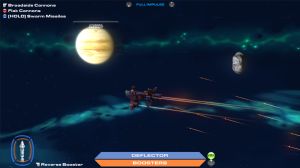
An exclusive short from an early prototype of the game that became Rebel Galaxy. Image: Travis Baldree.
Twenty minutes into the call, Travis dropped another bomb. “He says, ‘So, one thing I was wondering was, maybe you want to start a little company with me? Just the two of us, making your space game.’ It took me about 30 seconds, and then I thought, Oh my god, that sounds perfect. I’m definitely going to do that,” Erich said.
Erich hung up feeling motivated, yet sentimental. Soon, he would be able to roll up his sleeves and get up to his elbows in spreadsheets. In exchange, he would be taking this next big step without his long-time friend, business partner, and sibling. “I was bummed out to leave the guys at Runic, who are just super dudes. Especially, also, I was going to leave a company [I’d cofounded] with my brother, whom I’d been working with for over 20 years, and go start this new thing. But everything else was just ideal.”
Fortunately, his split from Runic would only be nominal. He and his brother had split a house in San Francisco for years, and he had no intention of moving. Neither did Travis. Erich could stay in San Francisco and spend time with his brother and their friends at Runic, and Travis could remain in Seattle where his family had put down roots.
Travis and Erich stuck around to help their soon-to-be-former teammates advance Hob until they had a cohesive, working prototype they could use as a foundation for the rest of the project. In late March 2014, Travis posted a message in the Runic forums thanking fans for their support and announcing his and Erich’s departure to form a new company. Their last day would be April 2nd. His post was emotional, tinged with “elation, fondness, fear, and bitter-sweetness.” At the same time, he was also “SUPER STOKED” to reveal the name of the company he and Erich would be founding: Double Damage Games.
No consensus. No bureaucracy. No bloated teams. “This was Travis’s idea when he proposed leaving Runic and starting this up: it would literally just be us two,” Erich said.
“That’s one of the reasons we named the company Double Damage,” Travis added. “We can’t even hire anybody, now.”
**
[1] In the interest of transparency, it should be noted that David L. Craddock worked on Hellgate: London following the game’s release. In 2008, RedBana, a studio based in the San Francisco Bay Area, received funding from Hanbitsoft to retool Hellgate: London for a relaunch in the Asia Pacific Territories. RedBana gutted many of the game’s mechanics, and David L. Craddock was hired to rewrite the script—character bios, item descriptions, dialogue for quests—from scratch.


Bibliography
* Two months later, Erich cofounded Flagship Studios: “Flagship Studios Opens with a Splash.” BluesNews.com. http://www.bluesnews.com/a/686.
* Essentially we grew too big, too fast: Interview with Erich Schaefer. All quotes from Erich Schaefer come from interviews conducted in 2015.
* It holds an aggregate score of 71% on Metacritic: “The Making Of: Hellgate London.” Edge-Online.com.www.edge-online.com/features/the-making-of-hellgate-london/.
* I’d been at WildTangent for five or six years: Interview with Travis Baldree. All quotes from Travis Baldree come from interviews conducted in 2015.
* a Diablo-style game codenamed Project Tugboat: “From the Ashes of Mythos: The Art of Torchlight.” Gamasutra.com.http://www.gamasutra.com/view/feature/4123/from_the_ashes_of_mythos_the_art_.php.
* Peter Hu, a programmer who had worked: “Mythos Team Reforms As Runic Games.” Gamasutra.com. http://www.gamasutra.com/php-bin/news_index.php?story=19769.
* their next project would be an MMO set in the Torchlight world: “Torchlight Hands On.” Eurogamer.net.http://www.eurogamer.net/articles/torchlight-hands-on.
* In late March 2014, Travis posted a message: “Announcement : Next Things.” RunicGames.com.http://forums.runicgames.com/viewtopic.php?f=2&t=59642&sid=e01161b6601dee85c0835bd395568b32.
Read more about:
Featured BlogsYou May Also Like